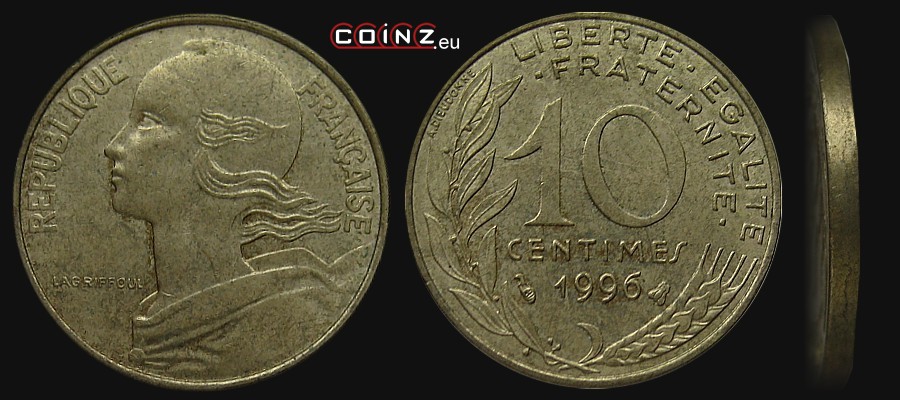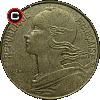10 centimes FRANCE (1962-2001)


| diameter: | weight: | thickness: | alloy: |
| 20.0 mm | 3.0 g | 1.45 mm | Cu92Al6Ni2 |
obverse:
in the coin centre personification of France - bust of Marianne in a Phrygian cap facing left; along the top edge: RÉPUBLIQUE FRANÇAISE (French Republic)
reverse:
in the coin centre in two lines large face value: 10 / CENTIMES; below year of issue; along the bottom edge wreath of the laurel branch on the left and cereal ear on the right; along the top right edge in two lines motto of France: LIBERTE • EGALITE / • FRATERNITE • (liberty, equality, fraternity)
edge:
plain
issue date:
13 XI 1961
withdrawal date:
18 II 2002
designer:
Henri Lagriffoul (signature LAGRIFFOUL at Marianne's neck in the obverse), Adrien Dieudonné (signature A.DIEUDONNE before LIBERTE along the reverse edge)
mint:
 La Monnaie de Paris (The Paris Mint), Paris (1962-1972), Beaumont-le-Roger (1965-1966) or Pessac (from 1973) (mint mark on the left side of the year of issue in the reverse, on the right side of the year of issue privy mark of mint's director Raymond Joly - owl - in years 1962-1974, Emile Rousseau - dolphin - in years 1975-1994, Pierre Rodier - bee - in years 1994-2000 or Gérard Buquoy - horseshoe - in 2001)
La Monnaie de Paris (The Paris Mint), Paris (1962-1972), Beaumont-le-Roger (1965-1966) or Pessac (from 1973) (mint mark on the left side of the year of issue in the reverse, on the right side of the year of issue privy mark of mint's director Raymond Joly - owl - in years 1962-1974, Emile Rousseau - dolphin - in years 1975-1994, Pierre Rodier - bee - in years 1994-2000 or Gérard Buquoy - horseshoe - in 2001)

mintage:
| 1962 | 29 100 000 | owl | |
| 1963 | 217 601 000 | owl | |
| 1964 | 93 434 600 | owl | + 25 600 in annual boxed sets |
| 1965 | 41 255 000 | owl | + 35 000 in annual boxed sets |
| 1966 | 16 429 171 | owl | + 7 171 in annual boxed sets |
| 1967 | 196 730 305 | owl | + 2 305 in annual boxed sets |
| 1968 | 111 703 000 | owl | + 3 000 in annual boxed sets |
| 1969 | 129 536 050 | owl | + 6 050 in annual boxed sets |
| 1970 | 77 030 000 | owl | + 10 000 in annual boxed sets |
| 1971 | 26 292 000 | owl | + 12 000 in annual boxed sets |
| 1972 | 45 715 000 | owl | + 15 000 in annual boxed sets |
| 1973 | 58 079 000 | owl | + 79 000 in annual boxed sets |
| 1974 | 92 088 811 | owl | + 98 800 in annual boxed sets |
| 1975 | 74 502 011 | dolphin | + 52 000 in annual boxed sets |
| 1976 | 137 355 711 | dolphin | + 37 500 in annual boxed sets |
| 1977 | 140 135 011 | dolphin | + 25 000 in annual boxed sets |
| 1978 | 154 384 011 | dolphin | + 24 000 in annual boxed sets |
| 1979 | 140 040 511 | dolphin | + 40 500 in annual boxed sets |
| 1980 | 140 010 011 | dolphin | + 60 000 in annual boxed sets |
| 1981 | 100 000 011 | dolphin | + 26 000 in annual boxed sets |
| 1982 | 110 002 511 | dolphin | + 27 500 in annual boxed sets |
| 1983 | 150 000 972 | dolphin | + 16 561 in annual boxed sets |
| 1984 | 200 002 447 | dolphin | + 13 836 in annual boxed sets |
| 1985 | 170 004 511 | dolphin | + 12 500 in annual boxed sets |
| 1986 | 150 007 011 | dolphin | + 15 000 in annual boxed sets |
| 1987 | 149 995 967 | dolphin | + 11 956 in annual boxed sets |
| 1988 | 145 890 576 | dolphin | + 10 565 in annual boxed sets |
| 1989 | 179 995 449 | dolphin | + 11 438 in annual boxed sets |
| 1990 | 180 002 011 | dolphin | + 10 000 in annual boxed sets |
| 1991 | 179 986 511 | dolphin | + 2 500 in annual boxed sets |
| 1992 | 129 970 709 | dolphin | + 2 698 in annual boxed sets |
| 1993 | 149 971 106 | dolphin | + 3 095 in annual boxed sets |
| 1994 | 103 000 000 | dolphin | |
| 1994 | 76 971 768 | bee | + 3 707 in annual boxed sets |
| 1995 | 169 980 011 | bee | + 4 000 in annual boxed sets |
| 1996 | 179 981 013 | bee | + 5 000 in annual boxed sets |
| 1997 | 551 991 013 | bee | + 15 000 in annual boxed sets |
| 1998 | 350 025 013 | bee | + 25 000 in annual boxed sets |
| 1999 | - | bee | + 25 000 in annual boxed sets |
| 2000 | 60 101 013 | bee | + 101 000 in annual boxed sets |
| 2001 | - | horseshoe | + 125 000 in annual boxed sets |
varieties:
In years 1991, 1992 and 1993 there exist coins with reverses not rotated by 180° in respect to obverses (medal alignment in American terminology), 2500, 2698 and 3095 pieces were produced in respective years and placed in annual boxed sets;
1994 - coins with a privy mark of mint's director Emile Rousseau dolphin or with the privy mark of Pierre Rodier bee
1994 - coins with a privy mark of mint's director Emile Rousseau dolphin or with the privy mark of Pierre Rodier bee
mint marks:
interesting facts:
The entire year 1965 and almost entire 1966 was produced in the Beaumont-le-Roger plant, but using exactly the same stamp as the Paris plant was using. In 1966 only 32 000 coins come from the Paris plant. It is however, impossible to distinguish these from the ones produced in Beaumont-le-Roger.
last update: 20 XI 2013
coins catalogue :: katalog monet :: münzkatalog :: catalogue de monnaies :: catálogo de monedas :: catalogo monete :: каталог монет :: κέρματα κατάλογος :: COINZ.eu
© 2010-2025 :: Adam Kubicki :: COINZ.eu :: All rights reserved.


